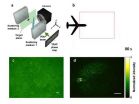(Press-News.org) WHITE PLAINS, N.Y., Nov. 3, 2014 – The March of Dimes is calling for a nationwide effort to reduce U.S. preterm births to 5.5 percent of all live births by 2030. Seven other developed countries already have preterm birth rates below 6 percent, and 15 have rates below 7 percent.
The U.S. rate of 11.4 percent in 2013 is one of the highest. The U.S. ranked 37th out of 39 high resource countries in 2010.
"The United States spends more money per capita on health care than almost any other country in the world, and yet our premature birth rate and our infant mortality rate are among the highest." says Dr. Jennifer L. Howse, president of the March of Dimes. "The U.S. should aspire to be among the best globally in preterm birth rates and give all our children a healthy beginning."
Writing in an article in Pediatrics published online today, Dr. Howse and her coauthors assert that the goal can be achieved by optimal use of known interventions and by studying countries with better outcomes. Interventions and risk reduction strategies known to prevent premature birth include:
Eliminating early elective deliveries before 39 weeks of pregnancy
Optimizing birth spacing (18-23 months between pregnancies)
Helping women quit smoking
Offering progesterone treatments for all women with a prior preterm birth
Reducing multiple births by following fertility treatment best practices
Offering low-dose aspirin to prevent pre-eclampsia in women with high risk pregnancies.
The authors also call for expanded funding for research to discover the unknown causes of premature birth and identify new interventions. The March of Dimes is funding a network of Prematurity Research Centers that currently include Stanford University, and a consortium of universities in Ohio including University of Cincinnati, The Ohio State University, and Case Western Reserve University. Two new research centers will be announced later this month.
Premature birth (before 37 completed weeks of pregnancy) is a serious health problem that costs the United States more than $26 billion annually, according to the Institute of Medicine. It is the leading cause of newborn death. Babies who survive an early birth face a higher risk than babies born full term of lifetime health challenges, such as cerebral palsy, visual and hearing impairments and intellectual disabilities.
About 450,000 babies were born too soon in 2013 in the United States out of nearly four million live births. Had the US achieved a rate of 5.5 percent in 2013, the number of babies born preterm could have been reduced by half. A rate of 5.5 percent would move the U.S. ranking to the top 10 percent of high resource countries.
INFORMATION:
The March of Dimes mission is to improve the health of babies by preventing birth defects, premature birth and infant mortality. The March of Dimes is the leading nonprofit organization for pregnancy and baby health. For more than 75 years, moms and babies have benefited from March of Dimes research, education, vaccines, and breakthroughs. For the latest resources and information, visit marchofdimes.org or nacersano.org. Find us on Facebook and follow us on Twitter.
Bird populations across Europe have experienced sharp declines over the past 30 years, with the majority of losses from the most common species, say the University of Exeter, the RSPB and the Pan-European Common Bird Monitoring Scheme (PECBMS) in a new study. However numbers of some less common birds have risen.
The study, published today in the journal Ecology Letters, reveals a decrease of 421 million individual birds over 30 years. Around 90 percent of these losses were from the 36 most common and widespread species, including house sparrows, skylarks, grey partridges ...
THE cancer drug eribulin, originally developed from sea sponges, could give women with advanced triple negative breast cancer an average of five extra months of life, according to research presented at the National Cancer Research Institute (NCRI) Cancer Conference in Liverpool today (Monday).
Researchers led by Professor Chris Twelves, based at the University of Leeds and Leeds Teaching Hospitals NHS Trust, looked at two major clinical trials of more than 1,800 women with breast cancer that had started to spread to other parts of the body. The phase III trials – ...
Bariatric (weight loss) surgery, such as gastric bypass or gastric banding, could reduce the risk of developing type 2 diabetes by around 80% in obese people, compared with standard care, new research published in The Lancet Diabetes & Endocrinology journal suggests.
Being overweight or obese is the main modifiable risk factor for type 2 diabetes. More than 80% of adults with type 2 diabetes are overweight or obese [1]. In England, just over a quarter of adults (26%) were classified as obese in 2010 (body mass index [BMI] 30kg/m2 or over)[2]. Up to 3% of people with ...
Cold Spring Harbor, NY – Scientists at Cold Spring Harbor Laboratory (CSHL) today announced a new way to dramatically increase crop yields by improving upon Mother Nature's offerings. A team led by Associate Professor Zachary Lippman, in collaboration with Israeli colleagues, has discovered a set of gene variations that can boost fruit production in the tomato plant by as much as 100%.
Plant breeders will be able to combine different gene variants among the set to create an optimal plant architecture for particular varieties and growing conditions. The set of mutations ...
A new study of the Amazon River basin shows lowland rivers that carry large volumes of sediment meander more across floodplains and create more oxbow lakes than rivers that carry less sediment.
The findings have implication for the Amazonian river system, which may be significantly altered by proposed mega-dams that would disrupt sediment supplies.
Researchers from Cardiff University's School of Earth and Ocean Sciences examined 20 reaches within the Amazon Basin from Landsat imagery spanning nearly 20 years (1985 to 2013).
They found rivers transporting larger amounts ...
CINCINNATI—An antibody abundant in mice and previously thought to offer poor assistance in fighting against infection may actually play a key role in keeping immune responses in check and preventing more serious self-inflicted forms of kidney disease, researchers say.
Led by researchers at the University of Cincinnati (UC) and Cincinnati Children's Hospital Medical Center and published online Nov. 2, 2014, in the journal Nature, the study finds that the mouse antibody IgG1, which is made in large quantities and resembles a human antibody known as IgG4, may actually ...
Two photons in free space do not interact. Light waves can pass through each other without having any influence on each other at all. For many applications in quantum technology, however, interaction between photons is crucial. It is an indispensable prerequisite for transmitting information through tap-proof quantum channels or for building optical logic gates. At the Vienna University of Technology (TU Wien), scientists have now succeeded in establishing a strong interaction between two single photons. This opens up completely new possibilities for quantum optics. The ...
As a child, it was fascinating to put a flashlight up to our palms to see the light shine through the hand. Washington University in St. Louis engineers are using a similar idea to track movement inside the body's tissues to improve imaging of cancerous tissues and to develop potential treatments.
Lihong Wang, PhD, the Gene K. Beare Distinguished Professor of Biomedical Engineering at the School of Engineering & Applied Science is applying a novel time-reversal technology that allows researchers to better focus light in tissue, such as muscles and organs.
Current ...
Nate Silver and Richard Feynman walk into a bar and bump into a biologist . . .
While this may sound like the setup to some late-night nerd sketch, researchers have taken this premise and applied it to an increasingly cumbersome problem in modern biology, namely, finding meaning in the rising oceans of genomic data.
In this specific instance, the data comprisesreams of cancer mutations that genome-wide studies are publishing at a dizzying rate. The challenge is finding new and efficient ways to parse the signal from the noise (and there is no shortage of noise).
As ...
A disappearing act was the last thing Rice University physicist Randy Hulet expected to see in his ultracold atomic experiments, but that is what he and his students produced by colliding pairs of Bose Einstein condensates (BECs) that were prepared in special states called solitons.
Hulet's team documented the strange phenomenon in a new study published online this week in the journal Nature Physics.
BECs are clumps of a few hundred thousand lithium atoms that are cooled to within one-millionth of a degree above absolute zero, a temperature so cold that the atoms march ...



